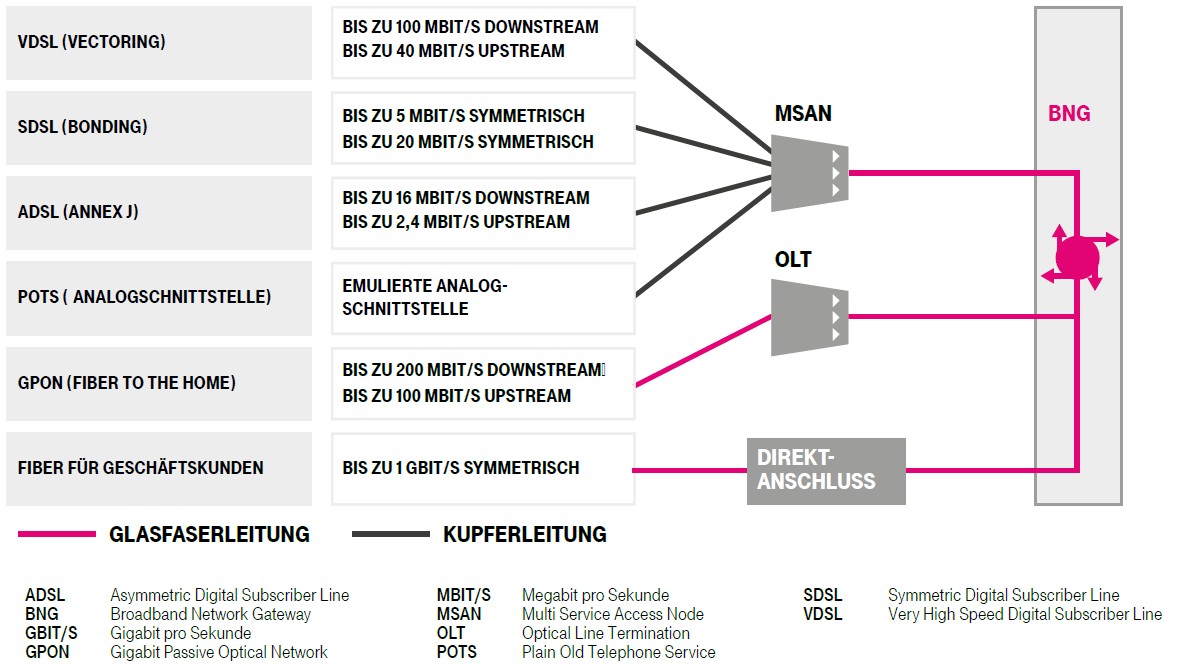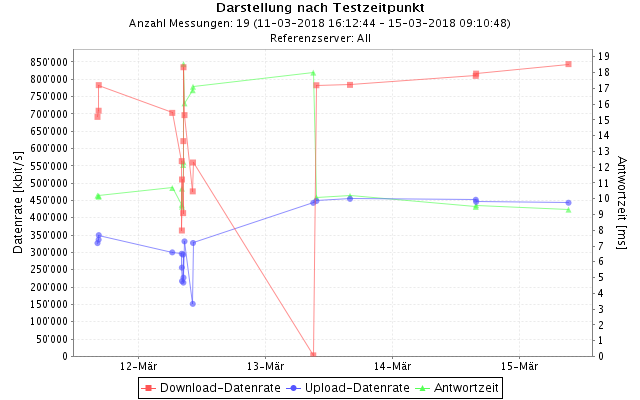Everyone is talking about the gigabit Internet. We already have it. Unfortunately, however, not all gold is gold and we suddenly discover completely new stumbling blocks. To want to have the quick connection and to get it in the end (at some point) is only one thing to use it optimally, a completely different one.
Update from April 30, 2018 10:45 AM
In the meantime, we have successfully completed the BNG migration and the result is quite impressive. We have appended the measurement results to the end of the article
What the article cannot and does not intend to do: we will not make a provider comparison, because by the use of the individual providers among each other or similar technology and infrastructure would remain too many ambiguities by in-house. In addition, the offers vary greatly from place to place and a really fair and objective assessment would also be just a short snapshot. And if we are honest: as much as we would have liked to have tested a second or third location, no one could offer us a similar connection for long-term measurements. Thus, we only have our own connection. But even he has it in him!
 We make one on a thick can: who has, who has.
We make one on a thick can: who has, who has.
Preliminary note on hardware selection during the long-term test
We have proven it often enough that mixing products from different manufacturers can be quite problematic. with different chips inside. Whether routers have problems with IP TV (multicast) or the Wi-Fi is not mesh-enabled, competing networks are just as deadly for performance as unexplained drops or even blackouts.
Everyone is free to use the trademark or use the manufacturer to whom he trusts or who appears to be the most favourable to him. But you have to be at least sure that e.g. the installed Wi-Fi chips in the interior harmonize with each other or offer all the features you would like for your purposes on the network. Otherwise you will quickly have a fallback to the lowest common denominator.

If we rely on AVM and so many Fritz! products in this first review and the following tutorials, then simply because we were able to cover (almost) all the individual areas. Where there are alternatives that we were able to install without any problems, we will of course also discuss them, because AVM offers e.g. switches. But you absolutely need this if you want to use a larger LAN structure. But let's start with the Internet provider, because you don't have to think about what doesn't even arrive at the can at home. The rest then comes another time.
BNG as a miracle weapon? What All-IP is all about
Nevertheless, we must once again slide into theory before continuing with practice. We all know the "forced change" of analogue telephone lines, but what exactly is behind it is usually not. BNG is Telekom's new magic word, although the new all-ip structure of other providers ultimately looks no (much) different. In addition to simplifying the structure, questions such as cost savings (for the provider) and possible (future-proof) expandability are also on the task list.
 Source: wik Consult Source: wik Consult |
 Source: wik Consult Source: wik Consult |
Without being too complicated now. we explain it in a very simplified way. The BNG (Broadband Network Gateway) is responsible for concentrating traffic from the end customer's connection to a Multi Protocol Label Switching (MPLS) IP router network. In the upstream, the traffic arriving via the Ethernet protocol must be bundled, checked and labelled before it can be fed into the MPLS.
In the downstream, the BNG takes traffic from the router network, removes the label and returns it to the customer's deadline via the Ethernet protocol. The BNG thus combines the functions of an Ethernet switch, a BRAS (Broadband Remote Access Server, e.g. access control to the IP network and the authorization or access to the booked services) and a label-edge router (LER) in a device.
 Source: Telekom AG
Source: Telekom AG
We see that the BNG first incorporates all existing techniques. That's why we forget for our article DSL and the just so hip VDSL (vectoring), because it is only a dead end in the end. FFTH (Fiber To The Home) is currently the new dominator on the fast lane of the data highway. But even if you end up with such a connection, not everything is as you would like it to be.
The discussion of how many Mbps it should then be in the down stream and upstream depends in turn on the provider and its possibilities, as well as on its own requirements (or claims). In the end, however, everything we write now applies to all speeds. Sometimes more and sometimes less, depending on.
Gigabit is not gigabit, just a "up to"
On the way to new down and upload records, Telekom has of course set us some stumbling blocks, which already starts with the fine print in the contract and is not to be read on the homepage with full-bodied advertising. The first kink in the mood barometer comes when you hold the order confirmation in your hands:
The minimum speed is 550 Mbps in download and 450 Mbps in upload. The maximum speed is 1,000 Mbps in download and 500 Mbps in upload. The normally available speed is 750 Mbps in download and 480 Mbps in upload.
This reads very differently, but it is not advertised in this way. Logical. But does what is guaranteed as a minimum package come to pass? Here too, however, we have our doubts. Because the more connections added to our OLT since October 2017, the worse the average data rates became. In addition, Telekom has been pushing ahead with the planned date for BNG migration like a pile of old snow for months and is now reacting very narrowly to questions to the press officer on the board.
The data rates were determined in daily, periodically consecutive multiple measurements over a total of 6 months. For this purpose, we have provided the services and/or the software of cnlab (software, with download), breitbandmessung.de and Oakla, as well as a separate data connection to a local server in the city and calculates averages for the months and the times of day.
In addition, we were not immune from network failures and days of performance slumps. Missing database entries, baffled technicians and extremely cumbersome support are not something that would have made life really easier in a specific case. As an example, we picked out four days of a week from one of the four parallel measurements, in which for days both the upstream and the downstream did not even offer what one actually paid for. In addition, Telekom not only struggles with a fee refund, but also switches completely to stubborn.
 Partial measurement at one of the servers
Partial measurement at one of the servers
Broken down by months, the picture looks rather mixed. First, let's look at the data rate for downstream. The averages are all above the guaranteed maximum, but they say nothing about the moments when nothing went at all.
For example, the worst values from November 2017 are always below the advertised minimum (in March, not even 6 Mbps were available by the hour, see previous partial diagram), while the averages steadily decreased from month to month. Although they are always above the guaranteed minimum, from November 2017 they are always partly well below the "normally available" speed. The maximum, like the minimum, always flows into the average and is a rather short-term phenomenon.

More interesting is the upload rate. Not only has it been falling continuously, but it has been consistently below what the Treaty guarantees since February. In March, barely 350 Mbps were possible for days, in places not even 300 Mbps. Questions in January from support with questions about a possible refund were completely ironed out and only the non-existent responsibilities were pointed out. After all, after 3 months and some calls in March, another technician came.

Also a replacement of the modem, as well as an addition of missing database entries brought only limited relief, because the minimum data rate during upload is always not quite (consistently) achieved, even if the advertised 450 Mbps are at least in sight.
Let's look at the evaluation by time of day, which we also had to carry out without BNG migration (which is supposed to solve all these problems), because Telekom has not been able to realize it on schedule:

We see the great dependence on the time of day with the big dents early in the morning and in the evening, which shows once again that Germany is obviously a people of early risers. It's going well, but we're divided about the monthly costs and the problems. When it's running: horny. Otherwise, there is a little lack of justification in front of your own wallet as to why it had to be Giga. But you may well need it.
Conclusion and summary
As beautifully healed as well advertised, the Mangenta world of the high-speed data highway is not quite so. However, we are hopeful that with the BNG migration still (sometime) to come, the last shackles can also be loosened. What really annoys us, however, is the provider's ignorance of the minimum data rates advertised. Even if it is only a little that is missing from the minimum value – too little is too little, since the mouse does not bite a thread. Refund slated to be a non-refundable issue, so the feeling remains that a premium price is far from guaranteed to receive a flawless premium product in the form to be expected. That, in turn, is quite annoying for us, already on principle.
Update from April 30, 2018
In the meantime, Telekom has now also managed to replace the narrow and completely congested uplinks and to ensure more bandwidth by means of a BNG migration. How constant this remains remains remains to be seen. But it's at least a good start. And this counts for the first time:

































Kommentieren